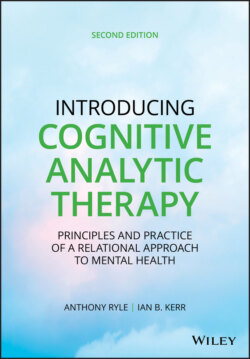Читать книгу Introducing Cognitive Analytic Therapy - Anthony Ryle - Страница 58
Contrasts with Other Concepts of Self
ОглавлениеThe CAT model of Self and its formation shares much with the different conceptions of self formulated historically by various clinical writers. These would include notably Jung (see Samuels, 1985), although Jungians have tended to neglect the social dimensions of the self, Sullivan (1953) within the North American “interpersonal” tradition, and Kohut (1977). CAT shares with Kohut an emphasis on the damage which can be done to the developing self by empathic failure or overt neglect but places more emphasis on active abuse and trauma. CAT also shares a central interest in social conceptions of the self with group analysts. Foulkes, for example, saw individuals in a social fashion as being nodes in a “social matrix” (Foulkes & Anthony, 1957). Later group analytic writers (e.g., Brown & Zinkin, 1994; Pines, 1996) have also developed an interest in the (Bakhtinian) dialogic aspects of the self.
Although object‐relations theorists were a major influence on the development of CAT, they were on the whole little interested in the concept of self. However, the current CAT model is close to some later authors in the object relations tradition, such as Sutherland (1980), Ogden (1990), and Sandler and Sandler (1998). It is also close to Bowlby's attachment theory (1988) and to subsequent work influenced by this (Fonagy & Target, 1997; and see Bateman, Brown, & Pedder, 2000) in their descriptions of the important role of internalization, and there are some similarities with more recent developments in cognitive psychology stressing the importance early interpersonal experience and of attachment patterns (see Gumley & Schwannauer, 2006; Guidano, 1987, 1991; Liotti, Cortina, & Farina, 2008; Neisser, 1993; Perris, 2000; Young, Klosko, & Weishaar, 2003). However, these authors do not take the further, and, in our view, important, conceptual leap of seeing the self as being essentially constituted by early, socially meaningful, sign‐mediated interpersonal experiences, as opposed to “representing” them mentally.
Nonetheless, object‐relations theories made a considerable contribution by indicating the importance of early development in determining personality, by offering an account of how parental figures were “internalized” to form a part of the personality, and by recognizing the parallel, linked features of intrapsychic and interpersonal processes and their emergence in transference relationships (see also discussion in Ryle, 1996, 1997c). However, the attribution of these phenomena by some psychoanalytic object‐relations theorists to “splitting” and “projective identification,” and the location of “psychopathology” in the posited internal system of object relations and to “ego weakness,” innate destructive instinctual forces, and unconscious fantasy is seen as unhelpful and untenable from a CAT perspective. The phenomenon of projective identification, whereby others are powerfully induced to experience feelings or play roles which the person cannot tolerate, is not regarded as a defense in CAT; it is seen to represent an exaggerated example of the normal empathic processes of RR relating. CAT understands Self states (dissociated RRs) to be precarious and to leading the person to induce powerful identifying responses in, or to forcefully seek reciprocations from, others even where these are harmful. While usually discussed in relation to destructive procedures, CAT would understand that the same intense pressures can characterize the seeking for “good enough” or ideal care.
